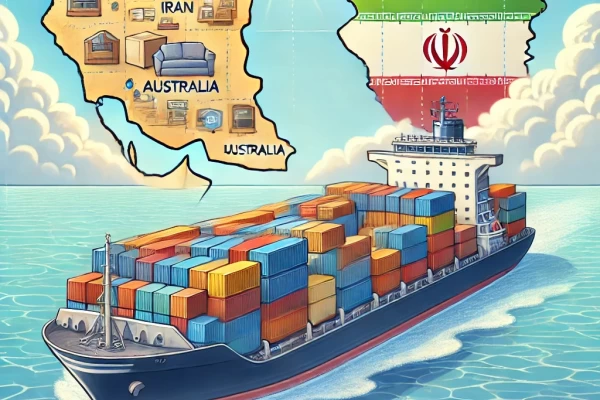Sea transportation of home appliances and furniture from Iran to Australia
Moving internationally can be a daunting task, especially when transporting household goods and furniture across continents. For individuals and families moving from Iran to Australia, one of the primary concerns is ensuring that their belongings reach their destination safely and efficiently. In this article, we will provide an in-depth guide to shipping household goods and furniture from Iran to Australia, covering the key steps, regulations, and costs involved in this complex process.
1. Understanding Shipping Options
When shipping household goods and furniture from Iran to Australia, there are two primary shipping methods: sea freight and air freight. Both have their advantages and drawbacks, depending on the size of your shipment, budget, and timeline.
- Sea Freight:
- This is the most common method for moving large volumes of household goods. Sea freight is cost-effective, especially for bulky items like furniture, but it is slower, with transit times ranging from 30 to 60 days depending on the shipping route.
- Air Freight:
- Air freight is faster but significantly more expensive. It’s generally reserved for smaller shipments or high-priority items that need to arrive quickly. Transit times range from 5 to 10 days.
2. Key Ports and Destinations
In Iran, major ports for international shipping include the Port of Bandar Abbas and Bandar Imam Khomeini Port. From these ports, your goods will be loaded onto cargo ships bound for Australia. The primary destination ports in Australia are:
- Port of Sydney (NSW)
- Port of Melbourne (Victoria)
- Port of Brisbane (Queensland)
- Port of Fremantle (Western Australia)
The choice of port depends on your final destination in Australia and the logistics provided by your shipping company.
3. Steps for Preparing Your Shipment
Before shipping your household goods and furniture, there are several important steps you should take to ensure a smooth process:
a. Inventory and Packing
Create a detailed inventory of all items you plan to ship. This will help with customs clearance and insurance claims in case of damage or loss. Use high-quality packing materials, such as bubble wrap, packing paper, and sturdy boxes, to protect fragile items. For larger items like furniture, consider professional packing services to avoid damage during transit.
b. Customs Regulations
Australia has strict customs and quarantine regulations to prevent the introduction of pests, diseases, and prohibited items. Some key points to consider include:
- Declared Items:
- You must declare all household goods and furniture upon entry into Australia. Items such as wooden furniture, outdoor equipment, and garden tools may be subject to quarantine inspection and treatment.
- Prohibited Items:
- Certain items are prohibited or restricted in Australia, including some plants, seeds, untreated wood products, and animal products. It’s important to check the Australian Border Force (ABF) website for the most current information on restricted goods.
- Quarantine Treatment:
- Australia’s Department of Agriculture, Fisheries, and Forestry (DAFF) may require that certain items be fumigated, treated, or cleaned upon arrival to ensure they are free from pests. Additional fees may apply for these treatments.
c. Choosing a Shipping Company
It’s essential to select a reputable international shipping company that offers services from Iran to Australia. Look for companies that provide comprehensive services, including packing, loading, customs clearance, and delivery to your new home in Australia. Request multiple quotes to compare prices and services.
4. Costs Involved in Shipping Household Goods
Several factors influence the cost of shipping household goods from Iran to Australia:
- Shipping Method:
- Sea freight is generally more affordable than air freight. Costs for sea freight range from $2,000 to $7,000, depending on the volume and weight of your shipment. Air freight can be significantly more expensive, ranging from $4,000 to $15,000 for similar volumes.
- Container Size:
- You can choose between a Full Container Load (FCL) or a Less than Container Load (LCL). FCL is ideal for larger shipments, where you will have exclusive use of a container (typically 20ft or 40ft). LCL is more cost-effective for smaller shipments, as you will share container space with other shippers.
- Insurance:
- It’s highly recommended to purchase insurance to cover the value of your household goods. Shipping companies typically offer insurance packages based on the declared value of your items.
- Additional Fees:
- Be aware of additional fees, including customs duties, quarantine inspection fees, and port charges. Your shipping company should provide a detailed breakdown of these costs in their quote.
5. Transit Time
The transit time for shipping household goods from Iran to Australia depends on the shipping route and the method used. Sea freight usually takes between 30 and 60 days, while air freight is much faster, typically taking 5 to 10 days. Factors such as weather conditions, port congestion, and customs clearance can also impact transit times.
6. Customs Clearance in Australia
Once your shipment arrives in Australia, it must go through customs clearance. You will need to provide the following documents:
- Bill of Lading (BOL): This document is issued by the shipping company and acts as a receipt for your goods.
- Packing List: A detailed list of all items being shipped.
- Proof of Ownership: Documentation showing that the household goods and furniture are your personal property.
- Passport and Visa: Proof of residency or visa status in Australia.
The customs process can take several days to complete. To avoid delays, make sure all documentation is accurate and provided to customs officials promptly.
7. Delivery to Your New Home
Once your shipment has cleared customs and quarantine, it will be delivered to your new home in Australia. Most shipping companies offer door-to-door services, which include unpacking and assembling furniture. Make sure to inspect your goods upon delivery for any damage that may have occurred during transit.
Conclusion
Shipping household goods and furniture from Iran to Australia involves careful planning, attention to customs regulations, and coordination with a reputable shipping company. By understanding the shipping process, preparing your items properly, and ensuring all paperwork is in order, you can make your international move as smooth and stress-free as possible.
Moving to Australia is an exciting new chapter, and with the right preparation, your belongings will arrive safely and on time, allowing you to settle into your new home with ease.
If you have any specific questions or need further assistance, feel free to ask!











